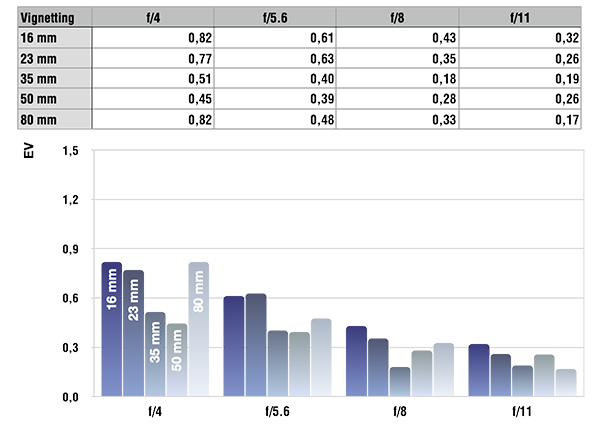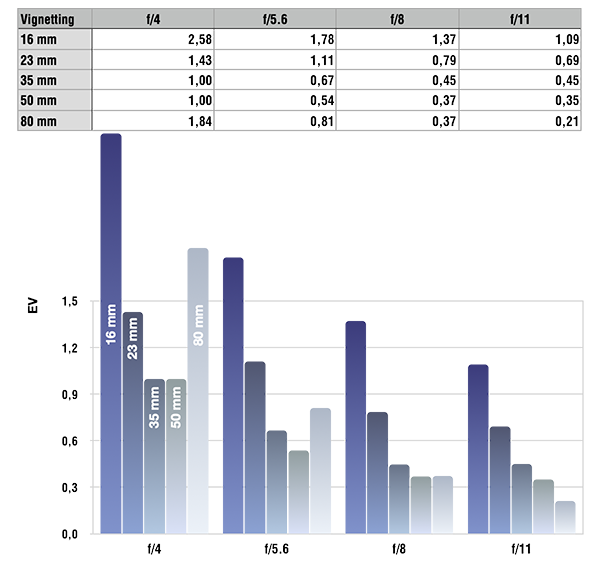|
Page 2 of 3

Distortion
Fujifilm applies software correction to many X-mount lenses, including this one. This typically leads to images with rather low to almost unnoticeable distortion. Throughout the whole zoom range, the distortion after correction is always of the pincushion type, a bit higher than one would expect at the wide end, slowly decreasing to really low numbers with longer focal lengths.
Because the correction can not be switched off in-camera, this is what you'll get when you shoot JPGs, and of course also what you'll always see in the viewfinder or on the rear display (before, during and after shooting).
Several RAW converters allow turning software correction off, so shooting RAW reveals the native distortion characteristics of the lens. And that's unfortunately a very different story than what's visible in the viewfinder.
At 16mm, there is a lot of barrel distortion. It's not the worst we have seen in a zoom lens, but it's not far from it and we have definitely seen better many times. At 23mm, distortion has already flipped over to pincushion style, very moderate, though. With higher focal lengths, the amount of pincushion distortion increases significantly.
It's important to keep in mind that distortion correction, especially correction of barrel distortion, comes at a price. It takes away some image angle, so the lens is actually a bit wider than what you see in the (corrected) viewfinder. In addition, it comes at the expense of some resolution loss especially in the image corners (we'll have a closer look at this below). In that context it's slightly surprising that Fujifilm actually over-corrects the distortion at 16mm.
Vignetting
Just as distortion, vignetting is auto-corrected, too. Even with that correction, the amount of light falloff is a bit on the high side at the largest aperture settings on both ends of the zoom range. As usual, stopping down reduces vignetting to lower levels and for medium and small apertures it should not be an issue for most subjects.
 Again, switching off correction reveals a less than exciting native performance of the lens. Especially at both ends of the zoom range, vignetting is very high wide open. At 16mm, it remains quite high even when stopped down considerably.
Again, switching off correction reveals a less than exciting native performance of the lens. Especially at both ends of the zoom range, vignetting is very high wide open. At 16mm, it remains quite high even when stopped down considerably.
Even though vignetting is easy to correct, the correction comes at a cost again. In this case it's the risk of increased (and possibly very visible) noise at the image corners, especially at high ISO numbers.

MTF (resolution)
The resolution characteristics of the XF 16-80 are a mixed bag. The center and near center performance is generally very good to excellent at the wide end, while a bit lower but still very good in the tele range.
The border and corner performance is a different story, though. At 16mm, borders are good, but corners just fair wide open. Stopping down helps to lift them to a good level, too.
At 23mm and 35mm, borders and corners show good resolution, stopped down even on the edge of very good. In fact, slightly stopped down at 23mm looks like the sweet spot of the lens.
At 50mm, the borders and corners show a somewhat strange and rare but not unprecedented behaviour. By stopping down from f/4 to f/5.6, the resolution drops from the initial level and then recovers to higher values at f/8 and f/11.
The biggest disappointment is the resolution at the longest focal length. The borders are fair, but the corners remain on a poor level, regardless of the aperture chosen.
Please note that the MTF results are not directly comparable across the different systems!
Below is a simplified summary of the formal findings. The chart shows line widths
per picture height (LW/PH) which can be taken as a measure for sharpness.
If you want to know more about the MTF50 figures you may check out the corresponding
Imatest Explanations
 The results above where measured with all software corrections turned off, so show the native performance of the lens. Because of the high amount of distortion that is usually auto-corrected, or which you may want to correct anyway if you shoot RAW, we also had a look at the MTF values with distortion correction enabled.
The results above where measured with all software corrections turned off, so show the native performance of the lens. Because of the high amount of distortion that is usually auto-corrected, or which you may want to correct anyway if you shoot RAW, we also had a look at the MTF values with distortion correction enabled.
In the charts below you can see that correcting the barrel distortion at 16mm has only little effect in most of the frame, but takes away roughly 10% of resolution in the image borders.
At 23mm the results are very similar, because only a very small amount of correction happens here.
Correcting strong pincushion distortion is less harmful to the resolution results, actually the borders even improve a tiny bit that way.

Chromatic Aberrations (CAs)
Lateral CAs (color shadows in the outer image field) are generally low to moderate at f/4 with a tendency to increase by stopping down, most obvious at the short focal lenghts. The only exception is 80mm, where CAs are a bit pronounced at f/4 already and stay more or less on the same level regardless of the aperture chosen.

Bokeh
A standard zoom with moderate aperture, the full-frame equivalent of f/6 in this case, is not the kind of lens you'd typically pick to shoot portraits or other images where you want to isolate the main subject from the background. Still, given the right combination of focal length (possibly long), aperture (large) and subject to background distance (far) you can still achieve a decent amount of background blur with this lens, too. So, let's have a look at the bokeh quality.
Out-of-focus highlights show some amount of outlining on the edges plus some onion-ring shapes on the inside. However, they remain nicely circular even at small apertures thanks to the 9 rounded aperture blades of the lens.
 The shape of the highlights deteriorates a bit towards the image borders due to mechanical vignetting at f/4. However, stopping down solves that issue. Again, one can see the onion-ring shapes on the inside of highlight discs, but also the round and circular shape even when stopped down to f/11.
The general rendition in the focus transition zones is quite smooth (for a standard zoom) in the background (to the left below) and a bit more nervous in the foreground (to the right below).
The shape of the highlights deteriorates a bit towards the image borders due to mechanical vignetting at f/4. However, stopping down solves that issue. Again, one can see the onion-ring shapes on the inside of highlight discs, but also the round and circular shape even when stopped down to f/11.
The general rendition in the focus transition zones is quite smooth (for a standard zoom) in the background (to the left below) and a bit more nervous in the foreground (to the right below).
 The analysis above was done at 80mm, because the longest focal length is the easiest to get some background blur. As with many zoom lenses, the bokeh quality varies a bit with the length. You can get an impression of the bokeh for the lower zoom range in some of the sample images on the next page. In general though, while the absolute bokeh quality is not outstanding, it is fairly ok and above average for a standard zoom.
The analysis above was done at 80mm, because the longest focal length is the easiest to get some background blur. As with many zoom lenses, the bokeh quality varies a bit with the length. You can get an impression of the bokeh for the lower zoom range in some of the sample images on the next page. In general though, while the absolute bokeh quality is not outstanding, it is fairly ok and above average for a standard zoom.
|